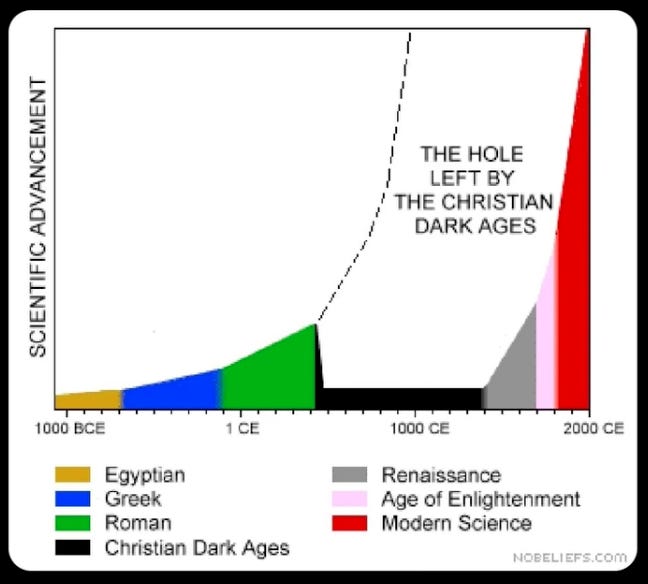When did medieval Europe overtake Rome?
And who would win in a fight between Julius Caesar and William the Conqueror?
One of the first substack pieces I started writing, way back in 2021, concerned a question that has always interested me: when did the medieval West overtake ancient Rome?
More specifically, in what century did medieval western Europe surpass the Roman Empire at its peak, in terms of population, military technology, literacy, state capacity to raise taxes and GDP per capita?
The idea first came about after someone on Twitter asked ancient historian Tom Holland who would win in a fight between the Romans and Normans, just the sort of slightly childish question I love to think about; as I recall, Tom thought that Norman cavalry would have been too strong, even if the Romans could call on far more men.
That’s a fun thought-experiment, but the wider question is important because the relative merit of the medieval period goes to the heart of our understanding of the past. Ever since Petrarch rediscovered Cicero’s letters in 1345, seen as the starting point for the Italian Renaissance, the idea of a ‘Middle Ages’ has been a source of dispute and controversy.
For the Renaissance men, as well as Protestant radicals and their 18th century Enlightenment successors, the medieval era was a time of darkness, superstition and priestcraft; for romantics and those sympathetic to Christianity, it was the foundation of our liberal moral order.
The question of whether modern Europeans had bettered the ancients was one that especially interested people in the 18th century, when the Romans became something of an obsession, especially among the French and Americans.
It was the subject of Benjamin Constant’s 1819 essay ‘The Liberty of Ancients Compared with that of Moderns,’ where he compared his world and theirs. Among his many arguments, Constant observed that commercial-minded Europeans were now much richer and safer: ‘This mass is strong enough to have nothing to fear from barbarian hordes. It is sufficiently civilized to find war a burden. Its uniform tendency is towards peace.’ (This was admittedly a strange thing to write so soon after Europe had endured a 20-year-long continental war, but he was largely correct).
This question is made murkier by many people confusing ‘Middle Ages’ with ‘Dark Ages’, the latter more accurately only referring to the early medieval or even the early part of that; the ‘Dark Ages’ essentially end with the Carolingian Renaissance, and a literacy drive led by the Northumbrian Alcuin, after which the number of manuscripts in Europe rose sharply.
This was followed by a population explosion from the ninth century, a result partly of a warming climate, but also the invention of the horse collar, which allowed for far greater agricultural yields.
It is with the reign of Charlemagne, the first ‘Emperor of the West’, that the Middle Ages proper begins. Yet we get all these people posting on Twitter a picture of a 13th century cathedral with the words ‘and they call these the Dark Ages’ (they don’t!).
The Carolingian Renaissance was the first of many ‘take-offs’ for Europe, as a result of which some 50,000 books were copied in the ninth century. This growth came from a low base, and Peter Brown wrote in The Rise of Western Christendom how western Christendom’s new libraries were very small: the Library of Reichenau had 415 volumes, which hardly compared to the libraries of antiquity, nor those of the contemporary Islamic world across the Pyrenees.
Yet while the question of when the medieval world overtook Antiquity feels hugely important, it’s hard to weigh up opinions and data. Luckily, or unluckily, we’re experiencing another take-off right now, even if it a very disconcerting one, with artificial intelligence - so for the first time I decided to ask AI to help with research, in this case Claude.ai. I’ve cited Claude for all the suggestions made by this vast, terrifying library of knowledge, but all of the writing is original.
Military
According to Claude, military technology was the first area in which medieval states overtook Rome, computer giving the period 750-800AD as the point, while literacy rates recovered last, in the 15th century. (You will always tell when I’m not copying AI, because Claude of course uses the hateful term ‘CE’).
Claude cites the arrival of stirrups during this period. ‘which enabled mounted shock combat that Roman cavalry never achieved.’ It states that ‘the stirrup, arriving in Western Europe by 750-800 CE, fundamentally transformed warfare by enabling mounted shock combat. While Romans possessed excellent cavalry, they lacked the stability for devastating lance charges that became the hallmark of medieval heavy cavalry.’ Just as Tom Holland says.
Then came castles, which surpassed Roman technology during the 11th century, although these were brought west from Constantinople which, you might say, was Rome. Claude cites Philippe Contamine, who wrote that the ‘great stone civilization of the castle’ was much more effective at withstanding sieges than any Roman walls. The Normans were especially skilled at castle-building, which was intensely competitive in western France, one reason they were able to subdue the English and rule a population vastly larger in size. By the late 13th century, motte-and-bailey castles had been replaced by concentric formations, far harder to penetrate. In Britain, these were taken to new levels by Edward I after the conquest of Wales which, as Bryan Ward-Perkins pointed out, was of course the last part of the former western empire overrun by Germanic barbarians.
Claude also points to the crossbow revolution of 1100-1200, weapons which were far more deadly than anything the Romans created, as well as trebuchets. The arrival of gunpowder in the 15th century then took European military capacity to a whole new level, and indeed the eastern empire finally fell in 1453 as a result of cannon – the year commonly regarded as the closing point of the Middle Ages.
Military technology is just one measure; another is masonry. John McNeill, an expert on the Romanesque, told me that medieval architecture bettered the ancient world around 1075-1100, in terms of sophistication. Old St Paul’s cathedral, completed in 1240, was the first building to tower over the works of antiquity, surpassed by Lincoln Cathedral in 1311 (although the spire collapsed in 1549); this was not bettered until 1884, and the Washington Memorial.
In terms of other forms of technology, it’s harder to say, but the 13th century saw a number of inventions that far surpassed ancient Rome, including eyeglasses, clocks and compasses.
Road building was probably one of the latest. In Britain, at least, it wasn’t until the 18th century that the road system left by the Romans was seriously improved upon. In Germany, it took until the 1840s for a new and enduring bridge to be constructed over the Rhine that hadn’t been built by the Romans.

Population
Rome reached one million people in the first century AD, a number that wasn’t overtaken in the Christian west until London in 1800 (although Islamic Córdoba in Spain certainly reached half a million in the years leading up to the millennium, perhaps ten or twenty times the size of the largest city in western Christendom). By the time of London’s rise, European civilisation had reached a sort of take-off and the British capital’s population topped 2 million before mid-century, and over 6 million by the end of it.
Claude estimates the empire’s population peak was ‘at 59-76 million people during the Antonine period (117-180 CE), with Italy alone housing 8-13 million inhabitants and Rome itself reaching one million’.
Economist Rafael Guthmann writes that during the early centuries of the Roman Empire the urban population of Europe reached a peak of 7 million people, ‘living in around 400 to 450 towns over 5,000 inhabitants’.
Then came the plagues of the second century AD, which helped reduce the urban population to around 4 million by the late fourth century, but things could only get worse from now on. The political collapse of the western empire in the fifth century was followed by the far more devastating Justinian Plague the following, which coincided with a period of extreme cold which also devastated the continent. The city of Rome fell to around 20,000 people after the Gothic War of the sixth century caused the destruction of the aqueducts.
By the 7th century, the depths of the Dark Ages, there were only around 30-40 towns with over 5,000 inhabitants, ‘from a peak of over 400 towns five centuries earlier’. The years around 700AD were a nadir, but Guthmann writes that Europe’s population began to recover after, and ‘from the 8th to the 14th century, the number of towns over 5,000 as well as the aggregate urban population increased by over an order of magnitude, reaching nearly 6 million urbanites spread over 400 towns just before the Black Death.’
Claude estimates that population levels recovered to Roman peaks during the 12th or 13th century. England had reached over 5-7 million by 1300, with France home to 20 million (then the ‘China of Europe’)
Although the Black Death and subsequent waves of bubonic plague killed up to half of Europe’s population, it had recovered its pre-plague population by the end of the 16th century; Guthmann writes that ‘from the 14th century to the late 18th century, urban growth continued as the urban population of Europe increased from 6 to 18 million and the number of towns over 5,000 inhabitants increased from 400 to 1,100.’



